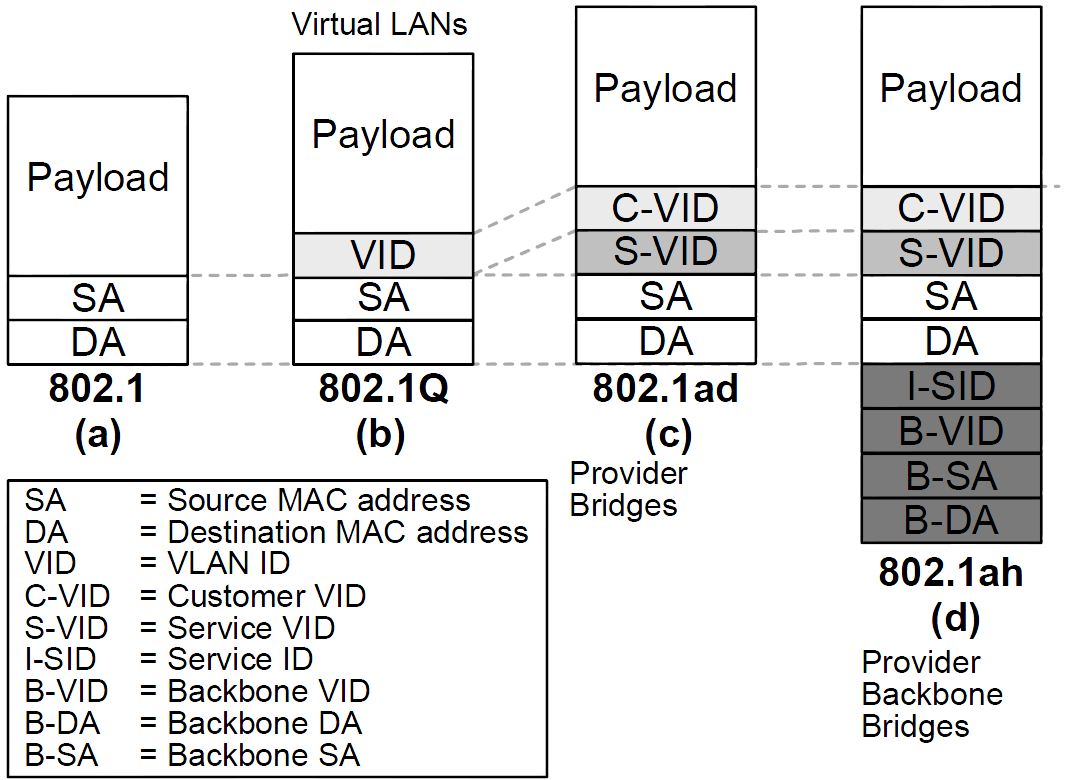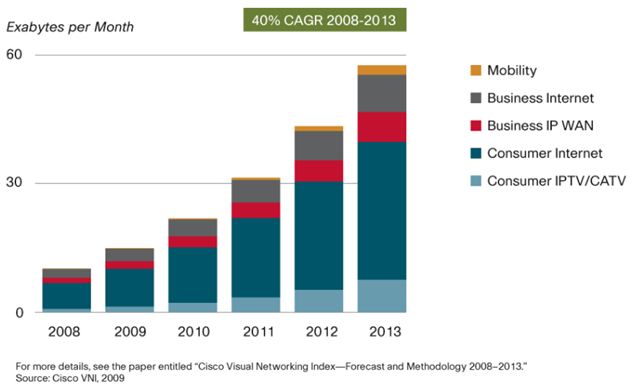|
|
Green Video-Dominated P-OTNs
Motivation
In their migration toward Next
Generation Networks (NGNs), today’s carriers
desire to integrate the latest packet networking
technologies such as connection-oriented
Ethernet and MPLS with installed optical network
technologies such as WDM, ROADM, and OXC, giving
rise to converged Packet Optical Transport
Networks (P-OTNs). P-OTNs aim at providing a
smooth migration platform toward an all-packet
infrastructure and addressing carriers’ drive to
investment protection and lower CAPEX/OPEX by
capitalizing on low-cost layer-2 switching
functionalities. This research tackles open
issues of emerging PBB-TE networks and explores
next-generation carrier Ethernet switch
architectures with advanced packet switching
capabilities and new forwarding models, paying
particular attention to their control,
evolutionary migration not only from legacy
SONET/SDH TDM but also widely deployed WDM
circuit-switched network infrastructures, as
well as their coexistence with IP/MPLS routers,
backward compatibility with existent Ethernet
switches, and further integration of new and
emerging standards.
Research Direction
Though IP/MPLS routers lead new
installations, there exists a huge base of
legacy SONET/SDH circuit switched time division
multiplexing (TDM) equipment dominating the
installed infrastructure of today’s backbone
networks. As a result of ITU-T’s Global
Standards Initiative (GSI), current widely
deployed circuit switching SONET/SDH networks
will evolve into NGNs whose transfer is based on
packets instead of circuits in order to converge
and optimize their operation and meet the
increasing demand for new multimedia services
and mobility.
Toward the realization of carrier Ethernet
networks, traditional Ethernet bridges/switches
must be gradually enhanced with advanced
capabilities and forwarding models, while at the
same time operating at ever increasing line
rates. In our research, we focus on the latest
carrier Ethernet technology called Provider
Backbone Bridge-Traffic Engineering (PBB-TE),
which was recently ratified in IEEE standard
802.1Qay in June 2009.
In order to provide transport features such as
wide-area scalability, fast recovery from
network failures, advanced traffic engineering
and end-to-end QoS, as well as operation,
administration, and maintenance (OAM)
capabilities, traditional Ethernet switches have
evolved into carrier Ethernet switches in
several steps. The step-by-step migration toward
carrier Ethernet implied a number of
evolutionary modifications of the original IEEE
802.1 Ethernet frame format, depicted in Fig. 1.

Fig. 1. Ethernet frame evolution (D. Allen et al.,2006).
Another interesting issue that motivates us for
a more scalable architecture is the latest
Internet Forcast of Cisco Visual Networking
Index. This forcast shows the huge growth in
Internet data traffic. As Fig. 2 shows, overall
IP traffic is expected to grow to 56 exabytes
per month by 2013, whereby 40 exabytes are due
to consumer Internet traffic.

Fig. 2. Cisco Forecasts 56 Exabytes per Month of IP Traffic in 2013.
Video will be responsible for the majority of
the traffic growth between 2008 and 2013. As
indicated in the Executive Summary of Cisco
Visual Networking Index June 9, 2009, The sum of
all forms of video (TV, video on demand,
Internet, and P2P) will account for over 91
percent of global consumer traffic by 2013.
Internet video alone will account for over 60
percent of all consumer Internet traffic in
2013. In 2013, Internet video will be nearly 700 times the U.S. Internet backbone in 2000. It would take well over half a
million years to watch all the online video that will cross the network each month in 2013. Internet video will generate
over 18 exabytes per month in 2013. Video communications traffic growth is accelerating. Though still a small fraction of overall Internet traffic, video
over instant messaging and video calling are experiencing high growth. Video communications traffic will increase
tenfold from 2008 to 2013. Real-time video is growing in importance. By 2013, Internet TV will be over 4 percent of consumer Internet traffic,
and ambient video will be 8 percent of consumer Internet traffic. Live TV has gained substantial ground in the past
few years: globally, P2P TV is now slightly over 7 percent of overall P2P traffic at over 200 petabytes per month. Video-on-demand (VoD) traffic will double every two years through 2013. Consumer IPTV and CATV traffic
will grow at a 53 percent CAGR between 2008 and 2013, compared to a CAGR of 40 percent for consumer Internet
traffic.
This research addresses open issues
of emerging PBB-TE networks and explores
next-generation P-OTN switch architectures with
advanced packet switching capabilities and new
forwarding models, paying particular attention
to their control, evolutionary migration not
only from legacy SONET/SDH TDM but also widely
deployed wavelength division multiplexing (WDM)
circuit-switched network infrastructures, as
well as their coexistence with IP/MPLS routers
and backward compatibility with existent
Ethernet switches. The following open issues
will be tackled in our research activities:
Convergence with IP/MPLS
PBB-TE introduces a connection-oriented forwarding mode to the data plane of
traditional connection-less Ethernet networks assuming that the forwarding tables of PBB-TE switches are populated
with ESP related table entries through an external control (or management) plane. The development of a control
plane to set up, modify, and tear down ESPs is currently one of the key open issues in PBB-TE. There is a risk to
be tempted to add too many replicated networking functions to Ethernet and thus lose its trademarks of low cost
and simplicity. Instead, Ethernet should be viewed as a highly effective complement to IP/MPLS and should not
attempt to replace it. Recently, Ethernet over MPLS (EoMPLS) transport services
over a Generalized MPLS (GMPLS)
controlled optical circuit-switched
network was successfully demonstrated.
However, this approach involves an
additional set of encapsulation
standards (so-called pseudo-wires) which
allow IP/MPLS routers to carry non-IP
traffic, e.g., Ethernet. As a result,
the complexity of the protocol stack is
increased significantly. In fact, many
carriers find that while IP/MPLS offers
many features, enabling them introduces
a whole new set of complex challenges,
e.g., troubleshooting. There is a need
for a different approach to converge
IP/MPLS and PBB-TE in order to carry
Ethernet frames natively. Given that
GMPLS supports a wide range of interface
switching capabilities and allows for
explicit constraint-based routing, and
the administrative benefits of using a
single control plane are enormous, the
GMPLS control plane is extended for
PBB-TE networks at present. This work in
progress is known as GELS.
Energy Consumption
An important feature of future network equipment is energy consumption in relation to
network operation as well as heat dissipation. Lowering energy consumption results in significant cost savings and
gives service providers a competitive edge. Power consumption represents one of the most serious obstacles
of expanding the capacity of today’s routers and switches due to their underlying optical-to-electrical-to-optical
(OEO) conversion, which is a highly power-consuming process. In fact, almost 50% of power is consumed by
OEO conversion and chip-to-chip communication.
forwarding mode to the data plane of
traditional connection-less Ethernet
networks assuming that the forwarding
tables of PBB-TE switches are populated
with ESP related table entries.
Flow Management
In today’s Internet, voice and video applications are exploding with an ever increasing
number of users streaming multimedia content to their PCs and wireless handhelds, e.g., iPhones and BlackBerrys,
and peer-to-peer (P2P) services
consuming more and more bandwidth.
Current routers and switches, including
PBB-TE switches, handle streaming media
on a per-packet basis where each packet
is processed and forwarded independently
from each other. As a result, each
individual packet’s destination address
must be looked up in the forwarding
table, switched, and stored in an output
queue instead of treating all packets
that are part of the same stream as a
flow. With flow management, a switch is
able to identify the first packet in a
flow and let the remaining packets of
the flow bypass the switching and
queuing stages, giving rise to new
forwarding models and resulting in
significant performance gains and
savings in terms of power, size,
complexity, and cost.
Extended Frame Sizes
For backward compatibility, PBB-TE still uses the original MTU of 1500 bytes. The
current maximum Ethernet frame size not only poorly matches the much larger MTU of 65536 bytes of IP/MPLS
routers, but more importantly degrades the performance of many of today’s attached servers dramatically, thus negating many of the initial benefits of high-speed Ethernet networks. Extending frame sizes is crucial to increase
the throughput of next-generation Ethernet networks and decrease the CPU utilization of attached servers.
Extended frame sizes yield significant benefits especially for large data transactions, e.g., storage and file backup,
and HDTV video, which has an average video frame size of 83300 bytes and is expected to dominate future Internet
traffic. Given the current Ethernet 32-bit frame check sequence, however, extended frame sizes must not exceed
11455 bytes to maintain the same bit error rate accuracy.
Researchers
Advisors
- Prof. Chadi M. Assi
- Prof. Martin Maier
Graduate Students
- Mohammad Nurujjaman Beajon
Publications
- M. Nurujjaman, S. Sebbah, C. Assi, and M. Maier,
“Optimal Capacity Planning and RPL Placement in Carrier Ethernet Mesh Network Design,”
Proc., IEEE International Conference on Communications (ICC), Ottawa, ON, Canada, June 2012.
- M. Nurujjaman, M. Sharifi-Rayeni, C. Assi, and M. Maier,
“Green Packet Optical Transport Networks (P-OTNs) Based on Photonic PBB-TE Switches and Minimized EEE Overhead,”
IEEE/OSA Journal of Lightwave Technology, vol. 30, no. 6, pp. 893-905, March 2012.
- M. Nurujjaman, M. Sharifi-Rayeni, C. Assi, and M. Maier,
“Minimizing EEE overhead in Green Packet Optical Transport Networks (P-OTNs),”
Proc., IEEE GLOBECOM, Houston, TX, USA, Dec. 2011.
|
|
|
|
| |